RON PITTAWAY'S WINTER FINCH FORECAST
2008 - 2009
(Reproduced with author's permission.)
|
|
Note: This page gives the text of Ron Pittaway's informative, educational and always interesting Winter Finch Forecast. He has gathered information regarding conditions in the northern boreal forests and synthesized this to forecast the occurrance of these birds in southern Ontario. There are excellent tidbits about food tree preferences of the various finch species and subspecies, and forest conditions overall. It will help you think globally to find birds locally. Many thanks to Ron for allowing us to offer this report to our visitors. (Photos added by NeilyWorld.)
|
|
Check the Birding Ottawa Past Years' Pittaway's Winter Finch Forecasts pages.
Check the current Birding Ottawa Pittaway Winter Finch Report page.
Check the most recent Birding Ottawa Winter Specialty Status page.
Check the Birding Ottawa Current Ottawa Winter List.
Return to Birding Ottawa Where and When to See Guide.
Return to Birding Ottawa Table of Contents.
Ron Pittaway's Winter Finch Forecast for 2008 - 2009
GENERAL FORECAST: This winter's theme is where will crossbills go and will they irrupt south? Both species wandered widely this summer. Cone crops are poor in the Atlantic Provinces and fair to moderate in Western Canada. In Ontario, spruce crops are fair to good west and east of Lake Superior and in central Ontario such as Algonquin Park, but cone abundance diminishes rapidly northwards into the boreal forest. White pine (Ontario's provincial tree) has heavy cone crops in most areas. The hemlock crop is poor in central Ontario. The white birch crop is fair to good west and east of Lake Superior to Lake Ontario, but poor in the boreal forest. The mountain-ash (rowan berry) crop is excellent in Ontario and Western Canada, but poor in the Atlantic Provinces. Individual finch forecasts below apply mainly to Ontario, but adjacent provinces and states may find the forecast of interest. I also comment on three irruptive passerines and two boreal forest raptors.
INDIVIDUAL FINCH FORECASTS:
PINE GROSBEAK: A mountain-ash berry specialist in winter, Pine Grosbeaks will stay north of most birders this winter because mountain-ash berries are abundant in northern Ontario. A few normally get south to Algonquin Park, but they are unlikely farther south.
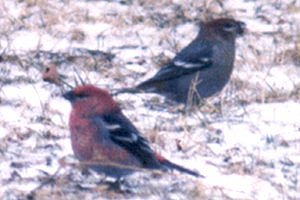 Pine Grosbeaks (Pinicola enucleator)
Pine Grosbeaks (Pinicola enucleator)
PURPLE FINCH: This finch stays in the north only when most tree species have heavy seed crops. This fall most Purple Finches will migrate south out of the province because overall tree seed crops are too low. A very few may winter in southern Ontario.
RED CROSSBILL: This crossbill comprises nine ecotypes in North America; each has cone(s) preferences related to bill size and shape.
The Types are difficult to identify in the field. Types 2 and 3 and probably 4 occur in Ontario. The white pine Type 2 is apparently the most frequently encountered Red Crossbill in the province (Simard
2007 in Atlas of Breeding Birds of Ontario). Since white pine has abundant crops in most areas, expect Type 2s to be widespread in small numbers. Hemlock Type 3 (subspecies sitkensis of AOU Check-list
1957) prefers the small cones of hemlock and white spruce when bumper in Ontario. Type 3s should be absent from the province this winter because the hemlock crop is poor and the white spruce crop is
average. Other Types are possible this winter given the bumper white pine cone crop and good crop on red pine. The Red Crossbill complex very much needs further study.
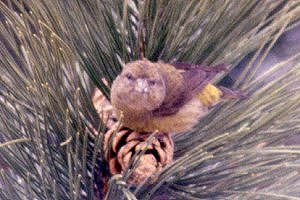 Female Red Crossbill (Loxia curvirostra)
Female Red Crossbill (Loxia curvirostra)
|
|
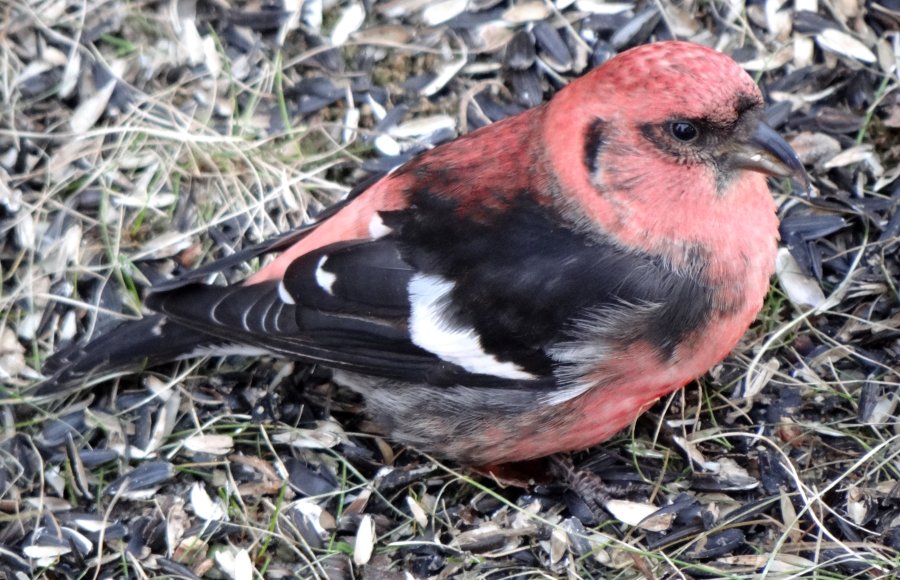 Male White-winged Crossbill (Loxia leucoptera)
Male White-winged Crossbill (Loxia leucoptera)
|
WHITE-WINGED CROSSBILL: This crossbill wandered widely this past summer searching for extensive spruce cone crops. Reports came from
Alaska, Yukon, Hudson Bay Lowlands, Ontario, Quebec and many northern states such as Michigan and New York. Most kept moving but some stopped and their singing suggested nesting but spruce cone crops are
generally not large enough in most areas to support major nestings. The White-winged Crossbill specializes on the small soft cones of black and white spruces and hemlock when bumper in Ontario. This
winter they should be widespread in small numbers in traditional areas such as Algonquin Park. However, spruce cone crops are generally low in most of Canada and as seed supplies are exhausted this fall and winter so a moderate southward irruption is probable, perhaps extending south into the central United States. Watch for them on ornamental spruces and European larch.
COMMON and HOARY REDPOLLS: The Common Redpoll is a white birch seed specialist in the boreal forest in winter. White birch crops are poor in the northern two-thirds of the boreal forest, but seed abundance increases southward. In central Ontario, such as Algonquin Park, crops on white and yellow birches range from fair to good. It is uncertain whether the birch crop is large enough to stop the southward movement in central Ontario about latitude 45 degrees. Some redpolls, including a few Hoarys, may get south to Lake Ontario if
birch seed supplies run low.
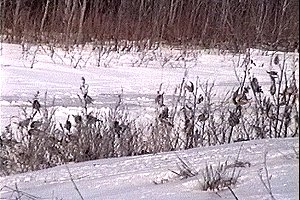 Flock of Common Redpolls (Carduelis flammea)
Flock of Common Redpolls (Carduelis flammea)
PINE SISKIN: A conifer seed specialist in winter, most siskins should leave the province this fall because the spruce cone crop is poor in the boreal forest. It is uncertain whether the huge white pine seed crop will keep some siskins in central and northern Ontario this winter.
EVENING GROSBEAK: A conifer and hardwood seed generalist in winter, Evening Grosbeaks should make a small southward movement this winter because food supplies are probably sufficient in the north. Older birders remember the 1970s when the Evening Grosbeak was a common feeder bird. Their memory is based on the greatly inflated numbers 30 years ago in Eastern Canada due to huge outbreaks of spruce budworm. The last Algonquin Christmas Bird Count to have high numbers of Evening Grosbeaks was in 1984 with 1474 individuals, which was the North American CBC record that year. A significant decline in grosbeak numbers began in the mid-1980s because the size of annual budworm outbreaks decreased. Ontario's breeding population is
currently probably stable, subject to periodic fluctuations in spruce budworm (Hoar 2007 in Atlas of Breeding Birds of Ontario).
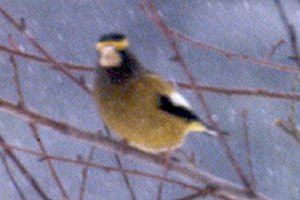 Evening Grosbeak (Coccothraustes vespertinus)
Evening Grosbeak (Coccothraustes vespertinus)
THREE IRRUPTIVE PASSERINES:
RED-BREASTED NUTHATCH: Movements of this nuthatch are linked to cone crop abundance, particularly spruce, white pine and balsam fir in
Ontario. Good numbers of Red-breasted Nuthatches should winter in Ontario this year feeding on the bumper white pine seed crop and good spruce/fir crops in many areas such as Algonquin Park.
BOHEMIAN WAXWING: Like the Pine Grosbeak, this waxwing is a mountain-ash berry specialist in winter. Mountain-ash crops are excellent across northern Ontario (bumper around Lake Superior) so very few Bohemians will wander out of the boreal forest this winter. Some may get south into traditional wintering areas of central Ontario such as Orillia, Peterborough and Ottawa where European mountain-ash berries are in good supply.
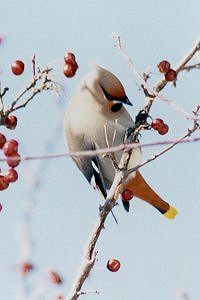 Bohemian Waxwing (Bombycilla garrulus)
Bohemian Waxwing (Bombycilla garrulus)
BLUE JAY: Good numbers of jays will winter in central Ontario because the red oak acorn crop is good and beechnut crop is fair in central
Ontario. Many other fruits and berries are abundant. Therefore this fall's flight should be average or smaller along the shorelines of Lakes Ontario and Erie.
BOREAL RAPTORS:
NORTHERN GOSHAWK: A small flight is possible this fall because high snowshoe hare populations have declined in much of northern Ontario.
However, grouse numbers (Ruffed, Spruce, Sharp-tailed) are generally good so they may buffer the decline in hares.
BOREAL OWL: Small mammal populations have crashed across northern and central Ontario. In Quebec, Pascal Cote of Observatoire d'oiseaux de Tadoussac expects a flight of Boreal Owls this fall and winter following their 4 year cycle linked to red-backed voles. Southern Ontario may get Boreal Owls and other northern forest owls this winter.
WHERE TO SEE FINCHES: A winter trip to Algonquin Park is a birding adventure. The park is a mix of boreal and hardwood habitats only a
three hour drive north of Toronto. Kilometre distances are marked from the west entrance. Watch carefully for crossbills and other finches in early morning eating road salt and sand. Two excellent
birding spots are the Spruce Bog Trail at km 42.5 and the gate area on the Opeongo Road about 4 km north from km 46 on the highway. Watch and listen for finches, Gray Jay, Boreal Chickadee, Spruce Grouse and Black-backed Woodpecker. The Visitor Centre and restaurant at km 43 are open only on weekends in winter. An observation deck overlooks a spectacular bog and black spruce forest. The feeders attract Evening Grosbeak, Pine Grosbeak, Common Redpoll and other finches depending on the winter. Gray Jays frequent the suet feeder and sometimes a pine marten or fisher goes to the suet. Eastern Canadian Wolves (Canis lycaon) are seen occasionally from the observation deck feeding on road-killed moose put out by park staff. Arrangements can be made to view feeders on weekdays. For information call the Visitor Centre at 613-637-2828.
ACKNOWLEDGEMENTS: I thank staff of the Ontario Ministry of Natural Resources (OMNR) and birders whose reports allow me to make annual
forecasts: Dennis Barry (Durham Region), Ken Corston (OMNR Moosonee), Pascal Cote (Tadoussac, Quebec), Shirley Davidson (OMNR Minden), Bruce Di Labio (Ottawa to Moosonee), Carrolle Eady (Dryden), Cameron
Eckert (Yukon), Bruce Falls (Brodie Club, Toronto), Brian Fox (OMNR), Marcel Gahbauer (Alberta), Michel Gosselin (Canadian Museum of Nature), Skye Haas (Michigan), Charity Hendry (Ontario Tree Seed Plant), Leo Heyens (OMNR Kenora), Tyler Hoar (Laurentians and Northeastern Quebec), Peter Hynard (Haliburton County), Jean Iron (Northeastern Ontario/James Bay), Christine Kerrigan and Peter Nevin (Parry Sound District), Richard Pope (Lake Superior), Bruce Mactavish (Newfoundland), Erwin Meissner (West Sudbury District), Scott McPherson (OMNR), Brian Naylor (OMNR North Bay), Larry Neily (Ottawa), Stephen O'Donnell (Parry Sound District), Fred Pinto (OMNR), Betsy Potter (Wilson, New York), Gord Ross (OMNR Moosonee), Rick Salmon (OMNR Nipigon), Don Sutherland (OMNR), Eve Ticknor (Ottawa), Ron Tozer (Algonquin Park), Declan Troy (Alaska), Mike Turner (OMNR Minden), Stan Vasiliauskas (OMNR), Mike Walsh (OMNR Muskoka/Parry Sound), Ben Walters (Northeastern Ontario), Alan Wormington (Point Pelee), Matt Young whose posts on New York State listservs were informative, and Kirk Zufelt (Sault Ste Marie). I
thank Ron Tozer for ongoing discussions on winter finches and Jean Iron for proofing the forecast.
PREVIOUS FINCH FORECASTS: archived at Larry Neily'swebsite in the Birding Ottawa Past Years' Pittaway's Winter Finch Reports section.
ATLAS OF BREEDING BIRDS OF ONTARIO 2007: The recently published Atlas of Breeding Birds of Ontario 2007 has detailed peer-reviewed information and maps on boreal winter finches. I highly recommend it.
http://www.birdsontario.org/atlas/index.jsp
Ron Pittaway
Ontario Field Ornithologists
Minden and Toronto, Ontario
18 September 2008
E-mail: jeaniron@sympatico.ca
Check the Birding Ottawa Past Years' Pittaway's Winter Finch Report page.
Check the current Birding Ottawa Pittaway Winter Finch Report page.
Check the current Birding Ottawa Winter Specialty Status page.
Check the Birding Ottawa Current Ottawa Winter List.
Return to Birding Ottawa Where and When to See Guide.
Return to Birding Ottawa Table of Contents.
|





